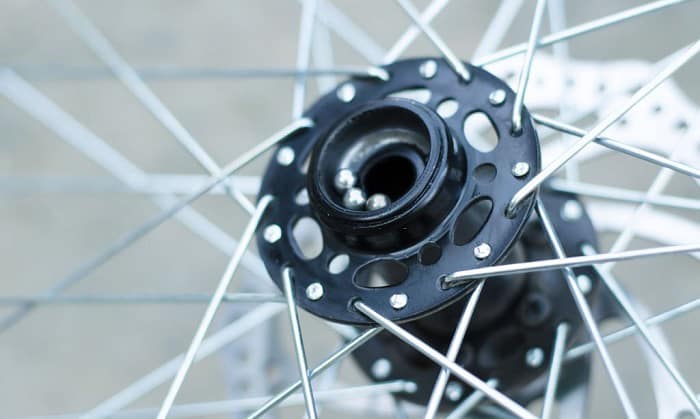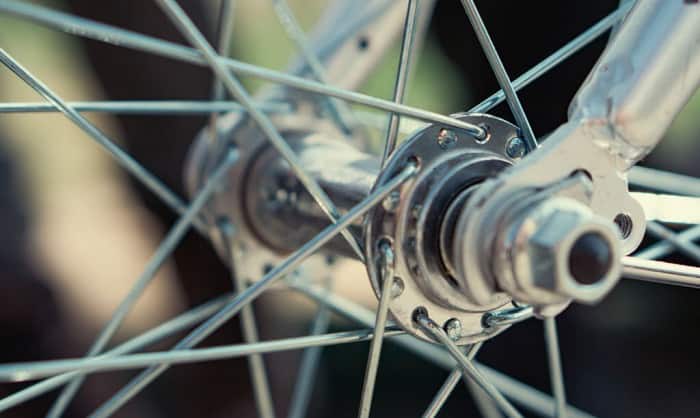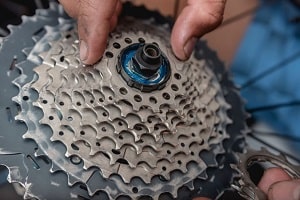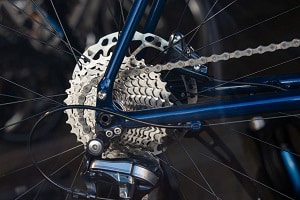Modern bicycles have been engineered and improved for better performance and safety. Much of the technological effort in them can be seen in bicycle hubs. But what is a hub on a bike?
The hub is found in the middle of the wheel where the spokes are connected and the center of the wheel’s axle rotation. It allows the wheel to turn and helps make bicycle operation faster and better.
Keep reading to learn more.
Table of Contents
The Bicycle Hub and Its Significance
1. What is a bicycle hub and its purpose?
The hub of a bike wheel is the center point of the wheel, where it connects to the bicycle frame via an axle. As the wheel rotates on this axle, the hub lets the bike run. A high-quality hub, meanwhile, can allow the bicycle to operate faster and more efficiently.
In addition, the bicycle hub also holds other components in place, such as the gears and the disc brakes.
2. What does a bicycle hub consist of?
The main parts of a bike hub are the body, bearings, and axle; we also have the ratchet and the cassette, but these are only found on rear hubs. The body or shell houses everything, as well as the flanges, where the spokes are slotted.
There are bearings on each side, and the axle sticks out from each side of the body. The ratchet and cassette are usually on the drive side of the rear hub bicycle wheel connected to the chain. Due to the additional components, these are bigger compared to the front ones.
3. Types of Bike Hubs
- Mountain bike hubs (MTB hubs)
As these are designed for more rigorous use, they are usually bigger than the standard hubs by 5-42 mm. They can be made of tougher and more durable materials, such as steel, to withstand more stress.
- Road bicycle hub
In contrast to MTB types, these are designed with speed in mind. This means that while they also need durability, it is more important to be lightweight and have high performance. The parts are more compact and use alternative materials, such as carbon fiber and ceramic.
- BMX hub
Compared to the two types above, BMX bicycles are smaller in size, so their hubs are scaled to match. Their designs are also designed to accommodate the nature of the cycling they are made for—performing stunts and racing.
BMX hubs have two sub-types:
-
- Flip-flop hubs: these have both free wheels and fixed gear cogs. Such a setup allows the user to switch between two riding styles – one for beginners to get used to the bike and the other for performing tricks.
- Single-speed hubs: These feature BMX and freewheel threads. They’re ideal for cruising.
- Freehub and cassette
This is an additional component connected to the wheel hub’s drive side that enables coasting on bicycles. The freewheel hub is the more traditional option, but the freehub has overtaken its use.
The notable difference is that the freehub’s ratchet is part of the main hub compared to the freewheel that has this on the sprockets.
- Front vs rear bike hub
Aside from the various types of hubs, it should be noted that the bicycle front hub also differs from the one at the back.
The front wheel takes on the work of steering the bike. Meanwhile, bike rear hubs facilitate the transfer of power generated from the pedals and transmit it to the rear wheel.
4. How Does It Work
To put it simply, the rear hub connects the chain to the wheel and facilitates the transfer of force from the pedal to the chain, allowing the wheel to turn. The main shell houses the smaller components and additional parts, like the freehub and cassette.
There are different kinds of bearings inside the hub, and the axle strikes through them and the hub body. When the axle turns, the motion is enhanced by the rotation of the hub giving the bicycle more power but also requiring less force to operate.
For the hub to perform seamlessly, these parts that come into play:
- The hub’s bearings are designed to reduce the friction between moving parts, allowing the wheels to rotate more efficiently.
- The cartridge bearings’ cases feature an inner and outer ring, with the ball bearings in the middle. The inside is lubricated with grease to promote movement and reduce friction for better performance. The rings keep the inside parts in line, which also helps promote movement.
The freehub connected to the rear wheel allows it to rotate, even when we stop pedaling. This coasting mechanism can differ depending on the type of freehub used, but the end result is always the same.
For instance, the pawl freehub mechanism works by having a set of spring levers working on the outer ring. When the pedal stops, the springs provide more movement driving the ring to keep moving and allowing the wheel to turn more. Meanwhile, the ratchet type uses two connected rings placed side by side instead.
5. Pros and Cons
The biggest benefit that hubs bring is speed and efficiency. Without them, we would need a lot of effort to keep our bikes moving. Not to mention that our riding speed would be much slower as well. They can also enhance our riding experience if we can use specialized hubs properly.
Lightweight hubs are well-suited for speed cycling, while durable types are better for performing stunts or taking on challenging tracks. However, using heavier models during a race could give us trouble instead.
Aside from the penalty of using the wrong type of hub, the biggest downside would be the necessary maintenance. A hub that is not properly maintained could be detrimental to us.
6. Price
Different types cost differently, and the road bike hub is known to be more expensive, although bike hub brands and material quality are also major factors.
High-quality models cost $200 to $400, a significant price increase from $20 to $90 for basic models.
However, high-quality hubs are usually made using lighter and more durable parts, with their weight going as low as 100 grams, so you also get more out of them. Premium models can cost up to $1000 or more but also provide significant performance upgrades. This price also applies to a high-end MTB hub upgrade.
7. Maintenance
Maintenance is another important consideration because the need for it can be frequent depending on your activities. Cartridge bearings cost more to maintain because these cannot be opened normally the way older bearing types can, although the need for cleaning is less frequent.
Mountain bikes are also known to require more maintenance due to the strain from the rough terrain, even more so when jumping is part of the routine. The dirt and mud also contribute to the need for more maintenance.
Things to Consider for Choosing the Right Hubs
Choosing a hub should be dictated by your cycling needs.
Look at what activities you plan on doing to get an idea of what you should get. It is also important to consider your bicycle frame and check which models are a good fit.
Bicycle wheel hubs should also be fitted accordingly. Rear hubs at 130 mm are wider than front ones at just around 100 mm, but those for an MTB are even wider—at 135 to 142 mm for both wheels. This ensures that there is enough space for everything required for such tough terrain.
Cost is an important consideration that we cannot overlook, but fitting your hub choice to your needs should be your top priority.
Conclusion
What is a hub on a bike? Now you have a better idea of how important they are and how the different types are used. Knowing more about them can help when choosing to buy a new bike or replacement components, so keep yourself open to learning more.
Have you had trouble with bicycle hubs before? What other bike components are you looking to learn more about? Drop us a suggestion in the comments section below. We always love hearing from our readers.
Read more: Bike pegs used for.

“I ride my bike to work for years, but is that enough? Our carelessness towards our surroundings has taken a toll on the environment. And now, everyone is responsible for changes; even the most minor contribution is counted. With this hope and spirit, I started with my partner to establish Biketoworkday to help more individuals commute to their work sites on their bikes.”








